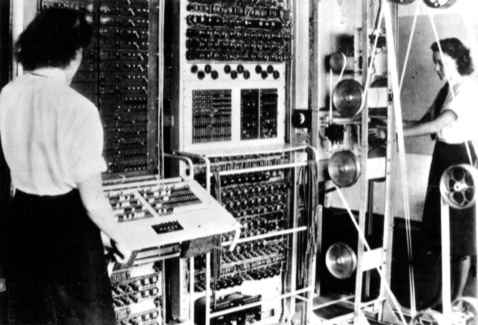| Codebreaking and Colossus |
| Written by Historian | |||||||
Page 3 of 3
ColossusThe Colossus Mark 1, built at Dollis Hill used 1500 valves - a huge number for the time, hence the name - was delivered in February 1944 and worked straight away. As explained by Joel Greenberg in the Bletchely Park video on the previous page (around 12:00), Flowers had already started work on the Colossus Mark II and so was able to deliver a bigger machine, with 2500 valves by the deadline of June 1944 in time for the D-Day Landings (Operation Overlord). Later in the video (from 13:30) Kevin Murrell recounts how Colossus reduced the decryption task that had taken 6 weeks manually to a matter of 6 hours. He demonstrates Colossus in operation using the replica Colossus Mark II that was the outcome of the reconstruction project by a team led by Tony Sale. For more on the rebuild project see our news reports The New Colossus Gallery and Colossus Re-enactment To Mark 70th Anniversary.
Colossus in use
Colossus occupied the size of a living room (7 ft high by 17 ft wide and 11 ft deep), weighed five tonnes, and used 8kW of power. It incorporated 2,500 valves, 501 of which were thyraton switches, about 100 logic gates and 10,000 resistors connected by 7 km of wiring. In total eleven Colossi were built and each incorporated minor differences to cope with the demands of the cryptographers. There was a natural tendency to build special hardware to speed up operations rather than generalize the hardware and use software as a solution. By the end of the war, 63 million characters of high-grade German messages had been decrypted by the 550 people working on the ten functioning Colossi at Bletchley Park and the knowledge obtained in this way is widely recognised to have shortened the war and saved countless lives. So was Colossus the first digital computer?In most people's opinion it wasn't. It was closer to a special purpose digital signal processor. Many of the logic units and principles of its operation are seminal computer techniques. It used synchronous clocked logic, had a memory, main control unit, branch logic and arithmetic units. At the time a bigger innovation was the simple faith needed to use so many unreliable valves. The trick was simply not to turn them off and weed out the early failures. After the initial burning in phase, valve failures were less of a problem than the electromechanical typewriters and the opto-paper tape readers. The Colossus team never made any attempt to formalise the stored program idea. In other words, its programs were built into it as part of the hardware and not stored along with the data. Mind you this is also true of ENIAC which is often cited as the first digital computer. For the legacy of Colossus you have to look to Alan Turing and the ACE computer system and the Manchester machines and these mainly made use of the fact that Colossus had proved that huge valve machines were possible. Working replicas of the Bombe and the Colossus have been constructed and are on display at the UK Museum of Computing (TNMOC). See: Colossus Re-enactment To Mark 70th Anniversary Bombe Goes On Display To Celebrate Alan Turing Anniversary
Comments
or email your comment to: comments@i-programmer.info |
|||||||
| Last Updated ( Monday, 27 November 2023 ) |



